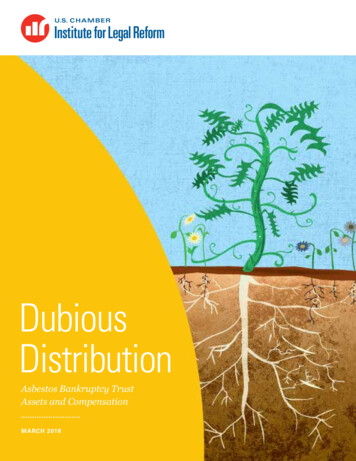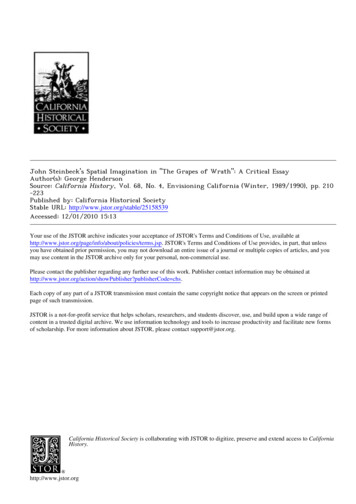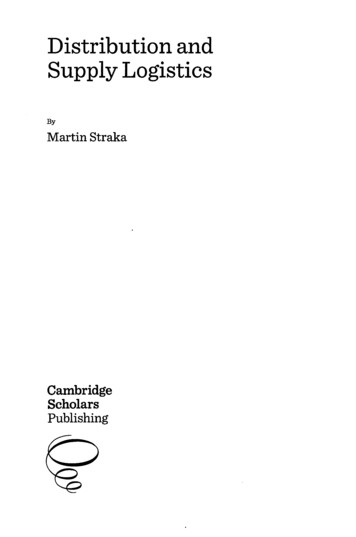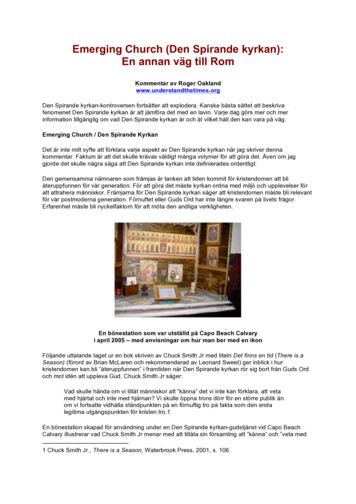
Transcription
DubiousDistributionAsbestos Bankruptcy TrustAssets and CompensationMARCH 2018
U.S. Chamber Institute for Legal Reform, March 2018. All rights reserved.This publication, or part thereof, may not be reproduced in any form without the written permission of the U.S. Chamber Institute for Legal Reform.Forward requests for permission to reprint to: Reprint Permission Office, U.S. Chamber Institute for Legal Reform, 1615 H Street, N.W.,Washington, D.C. 20062-2000 (202.463.5724).
Table of ContentsExecutive Summary.1Trust Financial Activity.3Trust Operational Expenditures.4Trust Net Claim Payments.5Trust Claim Payment Ratios.9Estimated Trust Distributions By Disease.12Recent Bankruptcy and Legislative Events.14Conclusion.18Prepared for the U.S. Chamber Institute for Legal Reform byPeter Kelso and Marc Scarcella, Roux Economic and Complex Analytics Practice
Executive SummaryDuring the past three decades, nearly 100 companies have filed forbankruptcy protection due, in large part, to asbestos-related litigation.1Many of these companies utilized Section 524(g) of the chapter 11bankruptcy code to reorganize.Bankruptcy filings under Section 524(g) areunlike traditional chapter 11 reorganizationsin that they are intended to resolve thedebtors’ financial obligations to futureasbestos claimants in addition to currentcreditors. Due to the latent nature ofasbestos-related injuries, where thediagnosis of an asbestos-related diseasecan occur decades after exposure, Section524(g) provides a mechanism forcontemporaneous resolution for bothcurrent and future asbestos personalinjury claimants.Confirmation under Section 524(g) requiresa 75% vote of the current asbestos creditorclass, whose interests are represented byan Asbestos Claimants Committee (ACC).The members of the ACC are typicallycomprised of plaintiffs’ law firms thatrepresent the largest number of lawsuitspending against the debtor at the time ofbankruptcy filing. By representing thelargest number of creditor votes, the ACChas immense negotiating influence overthe reorganization process, including theterms of settlement fund distributionfollowing confirmation.21To protect the interests of the creditor classof future claimants, the bankruptcy courtappoints a Future Claims Representative(FCR). Once established, the settlementtrust funds are managed by a board oftrustees and advised by both the FCR andACC representatives, who are collectivelyreferred to as the Trust AdvisoryCommittee (TAC).Therefore, the confirmation of a bankruptcyplan of reorganization under Section 524(g)theoretically represents a negotiatedsettlement between the debtors and legalrepresentatives of both current and futureclaimants, resulting in the creation ofsettlement trust funds to compensatecurrent and future claimants. However, asthe following statistics will show, of the 35trusts operating as of early 2008, 21 arepaying claimants less today than in 2008.And less than three cents for every dollardistributed by the trust system is dedicatedto examining the veracity of claimsubmissions.To examine the asbestos trust systemas a substantial source of claimantcompensation, we first began compilingDubious Distribution
detailed financial and claim activityinformation from publicly availablebankruptcy disclosures and postconfirmation trust annual reports in 2009.Our initial research and data compilationserved as the foundation for the 2010 studyby the RAND Institute for Civil Justice onasbestos bankruptcy trusts that includedtrust asset and compensation data through2008.3 Since then we have consulted onissues related to asbestos bankruptcy trustcompensation and governance fordefendants and insurers, providedresources to the GovernmentAccountability Office (GAO) for their 2011study on the asbestos bankruptcy trustsystem, and provided legislative testimonyU.S. Chamber Institute for Legal Reformon asbestos trust transparency bills at boththe state and federal level.The figures included in this report representa continuation of our work with trustdisclosures through 2016.4 While detailedinformation about individual claims made toand payments made from trusts is limited,these statistics are intended to serve as ageneral resource as to the financial andclaim-related activity of the asbestostrust compensation system. Thenumbers are clear: under the currenttrust distribution scheme and depletionrate, legitimate asbestos victims, includingfuture claimants, will continue tobe undercompensated.2
Trust Financial ActivityFigure 1 below illustrates the cumulative financial activity of theasbestos bankruptcy trust system between 2004 and 2016. During thisperiod, debtors and their insurers contributed nearly 40B to the trustsystem, which grew from 14 active, reporting trusts at the beginning of2004 to 58 active, reporting trusts by the end of 2016.In addition, the trust system benefited fromover 8B in investment gains and incomeover that same time period. The trustsystem paid out nearly 24B inadministratively-processed claims duringthe same period, which generatedapproximately 2B in trust administrative,oversight, operational, and legal expenses(Trust Expenses). As of year end 2016, thetrust compensation system still held nearly 25B in assets with more than 2B indeferred funding obligations, totaling justover 27B.IN MILLIONSFigure 1: Trust Cumulative Financial Activity (2004-2016) 50,000 40,000 30,000 20,000 10,000 0( 10,000)( 20,000)( 30,000)( 40,000)( 50,000)3Year-End Assets PlusDeferred Funding, 2016 27,074InvestmentGains/Income 8,637InsuranceSettlements 7,667BankruptcyFunding 32,001ClaimPayments( 23,805)TrustExpenses( 2,036)Taxes/OtherDeductions( 1,447)Dubious Distribution
Trust Operational ExpendituresAs noted above, the trust compensation system has distributednearly 24B in claim payments since 2004 relative to just 2B in TrustExpenses. Figure 2 provides a breakdown of Trust Expenses intosubcategories. Note that the largest Trust Expense category is forclaim processing at 28%.This implies that approximately 570M isspent on reviewing, qualifying, andprocessing claim submissions relative tonearly 24B in claim payments. To put thatin perspective, for every dollar the trustsystem distributes to claimants, trustsspend approximately 2.5 cents verifying theveracity of claim submissions.Figure 2: Trust Expense Detail28%ClaimProcessingCosts“28%Claim Processing Costs2%Other Expenses8%Trustee Fees and Expenses1%TAC Fees and Expenses2%FCR Fees and Expenses9%Professional Fees16%Investment Fees21%Legal Fees3%Insurance Expenses10%General Administration Expenses[F]or every dollar the trust system distributes to claimants,trusts spend approximately 2.5 cents verifying the veracity ofclaim submissions.U.S. Chamber Institute for Legal Reform”4
Trust Net Claim PaymentsAsbestos bankruptcy trusts are intended to compensate claimants fordecades into the future, and in almost all cases the trust assets arefunded at inception or in the years immediately following inception.To preserve assets for both current and future claimants, trusts relyon projections of near- and long-term claim filing and payment ratesto manage their cash flows.The primary mechanism by which a trustmanages its financial obligations iscommonly referred to as a “PaymentPercentage.” A Payment Percentageuniformly reduces the actual payment aclaimant receives. A trust can use thismechanism to manage its payments basedon expectations of future financialobligations. For example, a PaymentPercentage of 20% on a 100,000 qualifiedclaim value yields a 20,000 claim payment.When future liability expectations increase,a trust will normally decrease its PaymentPercentage, which in turn reduces the levelof individual claim payments and preservesa higher proportion of its current assets topay future claimants. Conversely, if futureliability expectations decrease, then a trustmay increase its Payment Percentage,which in turn increases individual claimpayments. For many trusts, whenpayments increase, prior claimants are5given retroactive, or ‘‘True-Up’’ paymentsequal to the difference between what theypreviously received from the trust and whatthe trust is currently paying similarlysituated claimants.There were 35 confirmed trusts as of thebeginning of 2008. Of those 35 trusts, 21are paying claimants less today than in2008. If a claimant received payments fromall 21 of these trusts today, he or shewould receive only 60% of what wouldhave been paid in 2008. In fact, in 2014 thenet recovery from the 21 trustsrepresented a 46% reduction compared toclaim payments in 2008. Figure 3 illustratesthe impact of Payment Percentageadjustments by these 21 trusts. Note thatthe first year (2008) is set to 100% andsubsequent years represent the level ofclaim payments relative to 2008.Dubious Distribution
Figure 3: Net Claimant Compensation Relative to 200821 Trusts That Pay LessToday Than in , only six of the 35 trusts activein 2008 have increased their paymentsto claimants. Moreover, three of those sixhigher-paying trusts have only increasedcompensation for specific regionalexposures, which limits the numberof individuals who will qualify forincreased payments.Figure 4 itemizes the Payment Percentagesof the 57 trusts that reported a PaymentPercentage as of 2017. Overall, 25 of the57 trusts are paying claimants less today ascompared to the later of 2008 or theirU.S. Chamber Institute for Legal , while 10 trusts are payingclaimants more. Overall, the averagemesothelioma trust payment net ofPayment Percentages has decreased from 48K in 2008 as measured across the 35confirmed trusts, to 37K in 2017 asmeasured across all 57 trusts. This is a22% decrease in average trust payoutdespite the inclusion of recently-confirmedand relatively high-paying trusts, PittsburghCorning and W.R. Grace, that are currentlypaying mesothelioma claimants on average 62K and 59K, respectively.6
Figure 4: Trust Payment Percentages as of Year -Best 7.4%AC&S .5%4.5%4.5%50%55%55%30%30%30%30%35%35%35%A.P. Green TrustAPI, Inc. TrustArmstrong World Industries Trust20%20%20%20%20%35%35%35%43%43%ARTRA %22%22%22%22%22%22%22%ASARCO TrustBabcock & Wilcox Trust34%15%15%11.9%7.5%7.5%7.5%11.9%11.9%11.9%E.J. Bartells %2.6%2.6%Brauer TrustBurns & Roe TrustC.E. Thurston & Sons TrustCelotex 26%26%Christy Refractories TrustCombustion Engineering TrustCongoleum TrustDII Industries Trust7Durabla Manufacturing TrustEagle-Picher Industries Trust38%38%38%31%31%28%28%33%33%33%Federal Mogul Trust te TrustG-I Holdings %J.T. Thorpe Trust (California)40%40%45%45%45%45%45%45%45%45%J.T. Thorpe Trust (Texas)38%57%57%57%57%57%57%57%57%33%Kaiser Aluminum & Chemical Trust39.5%39.5%39.5%35%35%35%35%35%35%35%Keene %40%5%5%5%5%H.K. Porter TrustHercules Chemical Company TrustLeslie Controls TrustABB Lummus Trust100%100%100%10%10%10%10%10%14.7%14.7%Manville %18%18%7%7%7%7%18.7%18.7%8%8%8%8%8%8%Metex TrustMotors Liquidation TrustMuralo Trust8%8%8%8%National Gypsum Trust55.6%55.6%55.6%18%18%18%18%18%18%18%NARCO board Trust (p/o OCFB)25%11%11%9.5%7.6%7.6%7.6%10.4%10.4%9%Owens Corning Trust (p/o urgh Corning Trust31%Plant Insulation Trust78.6%8.6%8.6%Plibrico Trust8.5%8.5%8.5%1.2%1%1%1%1%1.4%1.4%Porter Hayden us Distribution
Quigley TrustRaytech TrustShook & Fletcher 1%20%20%SPHC (Bondex) TrustState Insulation TrustSwan Trust20%T.H. Agriculture & Nutrition Trust20%100%Thorpe Insulation TrustU.S. Gypsum %25%45%45%30%30%20%20%U.S. Mineral Products Trust12.5%12.5%12.5%12.5%12.5%12.5%14%14%14%14%UNR ce & Gale 25%25%Western Asbestos TrustW.R. Grace TrustYarway TrustTo further quantify the impact of changesin Payment Percentages on net claimpayments, Figure 5 summarizes the netclaim payment for six large trusts (eightpotential payments) that were processingand paying claims through a sharedadministrator, the Delaware ClaimsProcessing Facility (DCPF), as of 2008.Figure 5: Net Mesothelioma Claim Payments From DCPF Trusts as of Year End8(In 2017Armstrong World Industries Trust 26 26 26 26 26 46 46 46 56 56Babcock & Wilcox Trust 41 18 18 14 9 9 9 14 14 14Celotex Trust 18 18 12 12 12 8 8 10 10 10Halliburton (p/o DII Trust)10 68 96 96 96 96 65 65 65 91 91Harbison-Walker (p/o DII Trust) 29 40 40 40 40 27 27 27 38 38Fibreboard Trust (p/o OCFB) 45 20 20 17 14 14 14 19 19 16Owens Corning Trust (p/o OCFB) 108 27 27 27 24 24 24 30 30 30U.S. Gypsum Trust 101 101 68 68 45 45 45 63 63 56TOTAL NET CLAIM PAYMENT 437 346 306 300 265 238 238 274 322 312—21%30%31%39%46%46%37%26%29%911PERCENTAGE CHANGE SINCE 2008U.S. Chamber Institute for Legal Reform8
Trust Claim Payment RatiosAs summarized in Figure 1 above, there are approximately 27Bin confirmed assets (inclusive of deferred and contingent funding),approximately 24B of which are associated with 32 trusts that governannual aggregate claim payments to malignant and non-malignantclaim groups through the application of a Claims Payment Ratio.In many cases, a trust will set a MaximumAnnual Payment (MAP) prior to eachcalendar year, which caps the cashpayments the trust can make to claimantsduring the upcoming year. The MAP isoften bifurcated into two funds based onthe Claims Payment Ratio, establishing aseparate MAP for malignant diseases,and in most cases, for severely disabled9non-malignant conditions (Category A).As summarized in Figure 6 below, thepercentage of trust assets earmarked forCategory A claims based on 2016 year endasset levels is approximately 73%.Conversely, 27% of claim paymentsare earmarked for less impaired ornon-impaired claimants (Category B).Dubious Distribution
Figure 6: Trust Assets Earmarked by Disease CategoryTRUST2016 YE ASSETSPittsburgh Corning TrustCATEGORY APAYMENT RATIOCATEGORY BPAYMENT RATIO 3,653,567,83360.0%40.0%W.R. Grace Trust2,995,017,71688.0%12.0%NARCO Trust2,677,742,39460.0%40.0%DII Industries Trust1,856,390,17260.0%40.0%U.S. Gypsum Trust1,492,720,43585.0%15.0%Armstrong World Industries Trust1,327,688,04865.0%35.0%ASARCO Trust121,060,707,18790.0%10.0%Flintkote Trust13880,000,00080.0%20.0%Quigley Trust826,658,89083.0%17.0%Owens Corning Trust (p/o OCFB)815,456,85365.0%35.0%Combustion Engineering Trust674,075,94887.0%13.0%Turner & Newall Trust (p/o Federal Mogul)567,915,60660.0%40.0%Kaiser Aluminum & Chemical Trust541,846,89670.0%30.0%SPHC (Bondex) Trust536,568,38185.0%15.0%Western Asbestos Trust528,140,89184.0%16.0%Babcock & Wilcox Trust472,584,55662.0%38.0%Fibreboard Trust (p/o OCFB)465,234,94665.0%35.0%Thorpe Insulation Trust464,755,16484.0%16.0%G-I Holdings Trust458,369,81585.0%15.0%T.H. Agriculture & Nutrition Trust352,906,86780.0%20.0%Yarway Trust325,986,53390.0%10.0%A.P. Green Trust288,141,37760.0%40.0%AC&S Trust220,513,18182.9%17.1%Congoleum Trust206,713,64175.0%25.0%Motors Liquidation Trust176,173,86080.0%20.0%J.T. Thorpe Trust (California)133,240,53690.0%10.0%Burns & Roe Trust130,314,49360.0%40.0%Plibrico Trust14101,964,64465.0%35.0%Leslie Controls Trust48,591,35280.0%20.0%ABB Lummus Trust26,555,94580.0%20.0%Christy Refractories Trust24,672,49090.0%10.0%ARTRA Trust21,188,37765.0%35.0% 24,352,405,02772.8%27.2%TOTALU.S. Chamber Institute for Legal Reform10
The Claim Payment Ratio provides anallocation of maximum allowable paymentsto each disease group or category. Whilemost trusts do not report claim paymentsby specific disease level (e.g.mesothelioma, lung cancer, asbestosis,etc.), many do provide a general breakdownby malignant versus non-malignant diseasegroupings. As noted in Figure 1, since 2004nearly 24B from the trust system hasbeen paid to claimants. Based on trustannual disclosures, it is possible to accountfor approximately 14B by malignant ornon-malignant disease groupings. Figure 7illustrates the percentage of claim paymentsto each disease group since 2004.Figure 7: Trust Claim Payments by Disease ALIGNANTSince 2009 the proportional level of nonmalignant claim payments has fluctuatedbetween 10% and 20%, with an average of14% during the last five-year reportingperiod from 2012 through 2016.15 Overallsince 2004, non-malignant claims havereceived 22% of trust claim paymentdistributions. Assuming this proportionholds, it implies that more than 5Bof the nearly 24B in trust claimpayments made since 2004 havebeen paid to non-malignant claims.11NON-MALIGNANT“[M]ore than 5B of thenearly 24B in trust claimpayments made since2004 have been paid to”non-malignant claims.Dubious Distribution
Estimated Trust Distributions By DiseaseAs previously noted, most trusts do not provide disease-level statisticsin their public annual reports. However, during the most recent fiveyear reporting period of 2012 through 2016, approximately 11 trusts onaverage have published aggregated disease-level payment statisticsacross 54 individual annual reports.16According to these annual reports, nearly87% of claim payments went to malignantdiseases, as compared to 86% in theaggregated data summarized in Figure 7during that same five-year span. Figure 8provides a breakdown of claim paymentsby disease, both before and after estimatedattorneys’ fees are withdrawn. The level ofattorneys' fees is generally based on thecontingency fee arrangements that eachplaintiff has with his or her law firm. In rareinstances, trusts may cap attorneys' fees.For example, the Manville Personal InjurySettlement Trust limits attorneys' fees to25% regardless of any prior feearrangement agreed to with a claimant;however, trusts that cap attorneys’ feesgenerally allow attorneys to charge theirclients for additional expenses.17Figure 8: Trust Claim Payments by Disease Group25%33%40%ATTORNEYS’ FEESMESOTHELIOMA72%54%LUNG AND OTHER CANCER48%43%DISABLING 7%Payments Before Payments NetPayments NetPayments NetAttorneys’ Fees of 25% Attorneys’ of 33% Attorneys’ of 40% Attorneys’FeesFeesFeesU.S. Chamber Institute for Legal Reform12
In most instances, trusts do not require acontingency fee cap and allow attorneys toobtain fees from trust payments in thesame percentage as the contingency feecollected by the attorneys in the tortsystem. This fee is often 40% of a client’soverall compensation. For example, in thecase of Barbara Jensen-Carpenter, Executrixof the Estate of Henry F. Carpenter v.AstenJohnson, Inc. et al., a Philadelphiajudge issued orders approving thedisbursement of 23 trust payments to theestate of a mesothelioma victim with 40%of the plaintiff’s compensation going to thelaw firm.18 According to petitions fordisbursement filed with the PhiladelphiaCommon Pleas court, the family of HenryCarpenter was entitled to trust payments“totaling 503,698.10 for his exposure toasbestos from the products of nowbankrupt companies. The plaintiff's law firmreceived 197,541.73 in fees (a 40%contingency fee) and an additional 3,401.59 for the reimbursement oflitigation costs associated with the filing ofthe trust claims.19 These payments weremade pursuant to the fee arrangementreached between the law firm and HenryCarpenter in 2013, prior to the filing of histort complaint and trust claim forms.20 AsFigure 8 illustrates, it is likely that less than50% of all trust assets are paid tomesothelioma claimants after attorneys’fees, payments to the other diseasecategories, and trust expensesare considered.[I]t is likely that less than 50% of all trust assets are paid tomesothelioma claimants after attorneys’ fees, payments to theother disease categories, and trust expenses are considered.13”Dubious Distribution
Recent Bankruptcy and Legislative EventsThe bankruptcy trust statistics show that the trust system continuesto be a substantial source of compensation. In 2017 there were severalevents that will expand the resources of the trust system, includingthe emergence of a 4 billion trust; the confirmation of a long-standing524(g) bankruptcy case; and a bankruptcy filing by one of the nation’slargest asbestos defendants.In March 2017, Pittsburgh Corningestablished its 4 billion asbestos trust aftera 16-year bankruptcy. In June, a NorthCarolina federal court confirmed the 524(g)plan of reorganization of long-standingdebtor Garlock Sealing Technologies, Inc. Inaddition, Bestwall LLC, which retainsliabilities previously defended by GeorgiaPacific, filed for Chapter 11 bankruptcyprotection in November, thus removing fromthe tort system a company that paid over 150 million annually to defend and resolveasbestos claims. Outside of these cases,several other bankruptcy proceedings headinto 2018 with outstanding asbestos-relatedissues, including Kaiser Gypsum, EnergyFuture Holdings, George V. Hamiltonand Oakfabco.212017 was also busy for state legislaturesseeking to enact legislation to bridge thedisconnect between the asbestos tort andbankruptcy trust compensation systems.Following the bankruptcies of many primaryasbestos defendants in the 2000s, statecourt systems that handle asbestos docketscontinue to grapple with how to properlyallocate liability among all potentially liableU.S. Chamber Institute for Legal Reformparties when bankruptcy trust filings andrelated exposures to bankrupt products arenot disclosed in tort proceedings in a timelymanner. One of the solutions has been statelegislation that grants courts the discretionto compel the production of trust claimforms early in tort discovery. Prior to 2017,eight states had passed trust transparencylegislation; 2017 saw four additional statesenact similar transparency bills.The following section provides more detailon some of the noteworthy bankruptcylitigation events in 2017 and passage ofstate trust transparency legislation.“One of the solutions hasbeen state legislation thatgrants courts the discretion tocompel the production of trustclaim forms early in tortdiscovery.”14
Asbestos BankruptciesPITTSBURGH CORNINGAfter 16 years of bankruptcy proceedings, thePittsburgh Corning Corporation AsbestosPersonal Injury Settlement Trust (PCC Trust)opened its doors on March 21, 2017.22Pittsburgh Corning filed for bankruptcy in2000 and was unable to finalize areorganization plan until April 26, 2016. Underthe terms of the plan, Pittsburgh Corning’sparent companies PPG and Corning fundedthe PCC Trust with nearly 4 billion in assets.The trust began processing payments at a31% Payment Percentage; however, itspayments were bifurcated with a 20%Payment Percentage applied to the firstpayment because of a potential shortfall oftrust assets due to an unanticipated numberof claims.23According to the PCC Trust, “a significantnumber of identified claimants have assertedthrough counsel that they hold pre-petitionliquidated claims within the meaning ofSection 5.2(a) of the TDP, alleging values wellin excess of those provided for in Section5.3(c) of the TDP for each particular diseaselevel The liability forecast relied upon toderive the Adjusted Payment Percentage ofthirty-one percent (31%) did not assume theDisputed Pre-Petition Liquidated Claimswould be payable from the Trust at thevalues alleged by the claimants; nor didit assume a resolution of the DisputedPre-Petition Claims would not ensure thatthe Asbestos PI Trust will be in a financialposition to pay holders of present and futureChanneled PI Trust Claims in substantially thesame manner.”24“The Pre-Petition Liquidated Claims, alsoknown as the Cimino claims, consist ofapproximately 2,000 asbestos claimants thathad filed lawsuits against Pittsburgh Corningin the 1990s and whose cases wereconsolidated but unresolved. In October2017, the PCC Trust reached a 178.5 millionsettlement with the Cimino class, agreeing topay the claimants 37.9 million and 140.6million more if an arbitration panel decidesthat other Cimino claimants hold pre-petitionliquidated claims.25 Previously, PCC arguedthat the claims should not be paid becausethey either never went to trial in the tortsystem or were overturned on appeal.GARLOCK SEALING TECHNOLOGIESOn June 12, 2017, a North Carolina federaldistrict court judge confirmed the bankruptcyreorganization plan of Garlock SealingTechnologies, ending a seven-yearbankruptcy proceeding.26 The case gainedtremendous attention due to the conclusionsthe judge reached after holding a hearing todetermine the company’s estimatedliabilities. In particular, he concluded thatGarlock’s experience in the tort system priorto its bankruptcy filing was “infected by themanipulation of exposure evidence” byplaintiffs and their law firms.27 The judge’sdetermination was made based on thousandsof case files that were produced throughextensive discovery of Garlock, asbestosbankruptcy trusts and plaintiffs’ law firms,highlighted by 15 exemplar cases thatGarlock used to illustrate the suppressionof trust evidence it experienced in statecourt proceedings.Garlock’s experience in the tort system prior to itsbankruptcy filing was ‘infected by the manipulation of exposureevidence’ by plaintiffs and their law firms.15”Dubious Distribution
Prior to its settlement in bankruptcy, Garlocksued several prominent plaintiffs’ law firmsfor civil racketeering under the RacketeerInfluenced Corrupt Organizations Act (RICO),alleging a scheme to intentionally defraudGarlock by suppressing evidence in hundredsof asbestos cases filed against the company.Those suits were dismissed as part ofGarlock’s bankruptcy settlement.Under Garlock’s bankruptcy plan, the trustwill be funded with 480 million in assets tocompensate current and future qualifyingasbestos claimants. The funding includes 400 million to be paid immediately, with 60million in cash and 20 million in stock to bepaid within a calendar year of theestablishment of Garlock’s trust.28 Prior to thedistrict court’s order, the bankruptcy court forthe Western District of North Carolinaentered an order on July 29, 2016, approvingGarlock’s plan and recommendingconfirmation subject to a vote on the plan.BESTWALLBestwall LLC (Bestwall) filed for Chapter 11bankruptcy protection in the Western Districtof North Carolina on November 2, 2017.29Bestwall is a successor to Georgia-PacificCorp., which was restructured in July 2017 toseparate Bestwall from a “new” GeorgiaPacific, align Bestwall’s business ofdefending asbestos claims, and create“additional optionality” for resolving itsclaims through a 524(g) bankruptcy. In itsfirst-day filings, Bestwall stated that ithistorically spent approximately 2.9 billiondefending and resolving more than 430,000asbestos personal injury lawsuits. Bestwallstated that it has paid over 2 billion ofthat overall amount net of insurance, andas of September 30, 2017, it is stillfacing approximately 64,000 pendingasbestos cases.30U.S. Chamber Institute for Legal ReformBestwall’s bankruptcy filings disclose howthe claims against the company spikedfollowing the 2000-2001 bankruptcy waveboth in terms of volume and indemnity. Priorto 2000, Bestwall was named in less than500 mesothelioma cases a year; however,following the bankruptcy wave of 2000-2001,mesothelioma claims against Bestwall“skyrocketed” and peaked at nearly 2,000annual claims in 2013. According to Bestwall,the cost to resolve the growing number ofclaims increased exponentially, with averagecosts for mesothelioma claims increasingfrom 20,000 per claim in the 1990s to morethan 125,000 per claim from 2010-2017.Bestwall’s reported overall annual defenseand indemnity costs rose to 184 million in2015 and 174 million in 2016. Prior to itsbankruptcy filing, Bestwall stated that it hadpaid approximately 200 million to resolveasbestos claims through October 2017.31In its filings, Bestwall states that its goal is to“negotiate, obtain approval of and ultimatelyconsummate a plan of reorganization thatwould, among other t
To examine the asbestos trust system as a substantial source of claimant compensation, we first began compiling . Eagle-Picher Industries Trust 38% 31% 28% 33% Federal Mogul Trust (T&N/Flexitallic) 6% Flintkote Trust 8% G-I Holdings Trust 8.6% 7.4% H.K. Porter Trust 4.6% 6.3% 4% 3%










